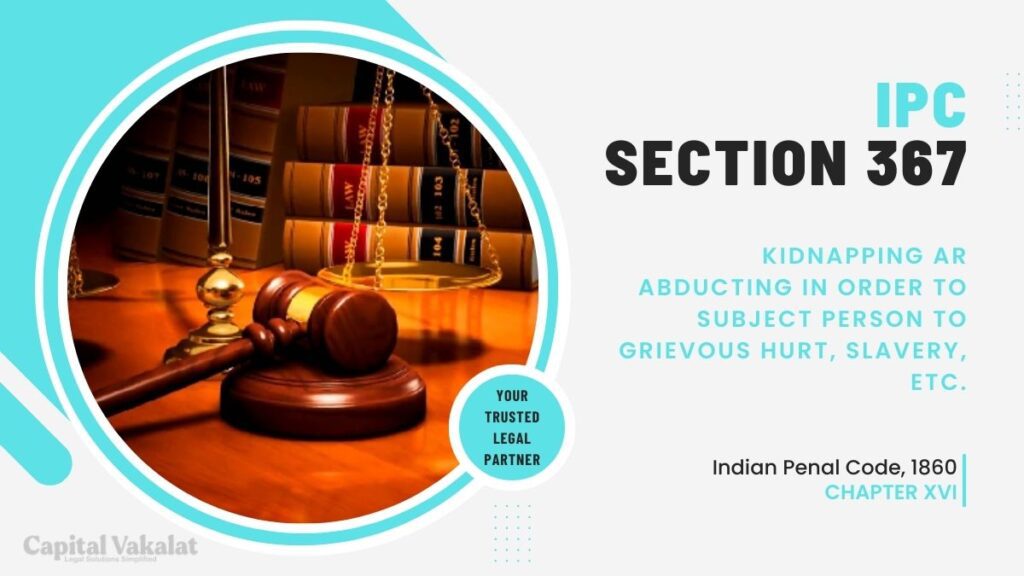Kidnapping and abduction are criminal offenses that strike at the core of individual security and societal well-being. In the Indian Penal Code (IPC), Section 367 stands as a formidable deterrent against those who engage in these heinous acts, especially when their intent is to subject the victim to grievous hurt, slavery, or other grave consequences.

In this article, we will delve into the intricacies of Section 367 IPC, exploring its various dimensions and implications.
Introduction to Section 367 IPC
Section 367 of the IPC serves as a legal bulwark against crimes involving kidnapping and abduction with the intent of inflicting serious harm. Understanding the nuances of this section is crucial for both legal professionals and the general public, as it encapsulates scenarios where the stakes are exceptionally high.
Kidnapping and Abducting Defined
Before diving into Section 367, it is imperative to comprehend the legal definitions of kidnapping and abduction. Kidnapping typically involves the unlawful taking away or transportation of a person against their will, while abduction encompasses similar acts but often with the motive of concealing the person’s whereabouts. These offenses are not only about physical confinement but also about violating an individual’s autonomy.
Grievous Hurt: A Serious Consequence
Section 367 IPC takes a severe stance by including the notion of “grievous hurt.” This legal term refers to injuries that are grave or serious in nature, extending beyond mere bodily harm. When coupled with kidnapping or abduction, the consequences become exponentially severe, warranting stringent legal actions.
The Menace of Slavery
What sets Section 367 IPC apart is its explicit mention of slavery. In the modern context, the term might seem archaic, but its inclusion is profound. This provision recognizes the potential exploitation and degradation a victim might face beyond physical harm, acknowledging the heinous crime of enslavement.
Section 367 IPC in Action: Case Studies
To grasp the real-world implications of Section 367 IPC, one needs to examine actual cases where this section was invoked. From high-profile abductions to cases with clandestine motives, the legal proceedings and outcomes offer insights into the effectiveness of this legal provision.
Understanding the Intent: Mens Rea in Section 367 IPC
Proving guilt under Section 367 IPC requires establishing the accused’s intent. The legal term “mens rea” refers to the mental state accompanying the criminal act. Unraveling the accused’s state of mind becomes pivotal in securing convictions under this section, adding layers of complexity to the legal proceedings.
Legal Penalties for Violating Section 367 IPC
The legal consequences for violating Section 367 IPC are severe, reflecting the gravity of the offenses it addresses. Comparisons with penalties under related sections further underscore the legislative intent to deter and punish those who engage in such nefarious activities.
Challenges in Prosecution
While Section 367 IPC serves as a potent tool for justice, challenges in its effective prosecution exist. From difficulties in gathering evidence to the reluctance of victims to testify, addressing these challenges becomes essential for ensuring that the legal system can deliver justice swiftly and effectively.
Impact on Human Rights
Balancing the enforcement of Section 367 IPC with the protection of individual rights is a delicate task. Analyzing the impact on human rights raises critical questions about the proportionality of legal actions and the necessity to safeguard civil liberties while ensuring public safety.
Public Awareness and Prevention
Preventing crimes under Section 367 IPC requires a multifaceted approach. Public awareness campaigns, educational initiatives, and community engagement play pivotal roles in creating a society where such crimes are less likely to occur. Proactive measures can make a substantial difference in curbing the prevalence of kidnapping and abduction.
Conclusion
Section 367 IPC stands as a robust legal instrument against crimes that jeopardize the safety and well-being of individuals. Its provisions, encompassing kidnapping, abduction, grievous hurt, and slavery, underscore the legislative commitment to protecting citizens from grave harm. However, the effective implementation of this section necessitates addressing challenges in prosecution, upholding human rights, and fostering public awareness.
Frequently Asked Questions
How can the public contribute to preventing crimes covered by Section 367 IPC?
Public awareness, reporting suspicious activities, and supporting community initiatives are key ways the public can contribute to preventing such crimes.
What distinguishes “grievous hurt” from regular bodily harm under Section 367 IPC?
Grievous hurt involves injuries that are severe and grave, extending beyond ordinary bodily harm. The distinction often lies in the intensity and lasting impact of the injuries.
Is Section 367 IPC applicable only to physical acts of harm, or does it include psychological harm as well?
Section 367 IPC primarily focuses on physical harm, but in certain cases, psychological harm that leads to serious consequences may also be considered.
Are there any proposed reforms to address challenges in prosecuting cases under Section 367 IPC?
Legal experts and policymakers are continually exploring reforms to streamline the prosecution process, address evidentiary challenges, and ensure a fair and swift judicial response to offenses covered by Section 367 IPC.